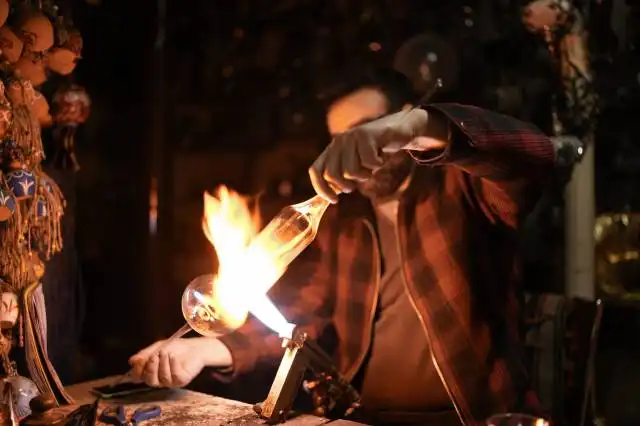Start a Custom Doll Business
Crafting Memories and Comfort: The Magic of Custom Doll Business
| Updated


CUSTOM DOLL BUSINESS
If you're blessed with a creative streak and have an affinity for toys, initiating a custom doll-making business could be the entrepreneurial journey to embark on. This venture involves designing, creating, and selling unique, personalized dolls crafted based on the customers' specifications. Your magical touch could breathe life into every cotton-stuffed figurine, turning kid's drawings or pictures into tangible, huggable companions. By launching a custom doll business, you're not just selling dolls, you're selling memories, personalized comfort, and potentially even little mini-mes for those who always dreamt of it!
Jump to Business Plan
RELATED BUSINESS IDEAS
Browse ALL Arts & Crafts Business Ideas
Discover Your Perfect Domain
Unlock the door to your online success with our hand-picked selection of premium domain names. Whether you're starting a new venture or rebranding an existing one, the right domain can set the tone for your digital presence. Browse through our curated list, each with its unique potential to enhance your brand's visibility and credibility.
CUSTOM DOLL MINI BUSINESS PLAN
This a quick reality check to help you identify the strengths and weaknesses of your business concept before you dive in.
Expected Percent Margin:
- Gross Margin: 60-80%
- Net Profit Margin: 20-35%
Earnings Expectations:
- Daily Earnings: $100 - $300
- Weekly Earnings: $700 - $2,100
- Monthly Earnings: $3,000 - $9,000
- Annual Earnings: $36,000 - $108,000
Actions to Hit Those Numbers:
Inventory and Production:
- Initial Investment: At least $2,000-$3,000 for crafting materials and tools.
- Supplier Contacts: Establish connections with reliable suppliers for raw materials.
Marketing and Customer Acquisition:
- Online presence: Marketing via platforms like Etsy, eBay, and social media networks.
- Photography skills: High-quality photos showcasing the uniqueness and detailing of each doll.
Sales and Customer Experience:
- Pricing: Custom dolls can be priced between $50 - $300 depending upon the detailing, size, materials, and time invested in each doll.
- Packaging: Invest in attractive, secure packaging to ensure your products arrive in pristine condition.
Cost Control:
- Home-based: Working from home can save plenty of costs regarding rent and utilities.
Business Operations:
- Order Fulfillment: Aim for at least 2-5 orders per day maintaining high-quality and unique customization.
- Time Management: Efficiently divide your time between crafting, organized inventory, and proactive marketing.
Remember, the success of a custom doll business relies heavily on creativity, quality, and unique offerings. Enhance these aspects and maintain a robust digital presence! These are broad estimates and can vary based on the doll's complexity, location, and existing demand.
NOT WHAT YOU HAD IN MIND? Here are more ideas



Browse ALL Arts & Crafts Business Ideas
Grab Your Business Website Name
Before you get caught up in the whirlwind of setting up your business, invest in a domain name. It's a small but significant step that lays the foundation for your brand and makes it easier for customers to find and trust you. Just like you wouldn't build a house without securing the land first, don't build a business without securing your domain name.
"Why? Can't that wait?" Here's why it shouldn't
Step 1: Determine if a Custom Doll Business is Right for You
Breakdown of Startup Expenses
Before starting a custom doll business, it is important to understand the startup costs associated with the venture. This includes the cost of materials, such as fabric, thread, stuffing, and other supplies. Additionally, the cost of any equipment needed to create the dolls, such as sewing machines, cutting tools, and other tools should be factored in. It is also important to consider the cost of marketing materials, such as business cards, flyers, and website design. Finally, the cost of any licenses or permits needed to operate the business should be taken into account.
Breakdown of Ongoing Expenses
Once the business is up and running, there are ongoing expenses to consider. This includes the cost of materials, such as fabric, thread, stuffing, and other supplies. Additionally, the cost of any equipment needed to create the dolls, such as sewing machines, cutting tools, and other tools should be factored in. It is also important to consider the cost of marketing materials, such as business cards, flyers, and website design. Additionally, the cost of any licenses or permits needed to operate the business should be taken into account.
Examples of Ways to Make Money
Once the business is up and running, there are many ways to make money. One way is to sell the custom dolls directly to customers. This can be done through an online store, at craft fairs, or through other retail outlets. Additionally, custom dolls can be sold to wholesalers or distributors, who will then resell the dolls to retailers. Another way to make money is to offer custom doll-making classes or workshops. Finally, custom dolls can be used to create unique gifts or promotional items for businesses or organizations.
Step 2: Name the Business
Naming a business can be a difficult task, but it is an important step in starting a custom doll business. It is important to come up with a name that is memorable, unique, and reflects the business’s mission. To start, brainstorm ideas and create a list of potential names. Consider using a combination of words that are related to the business or that have a special meaning. Additionally, research the names to make sure they are not already in use. It is also important to make sure the name is easy to spell and pronounce so that customers can easily find the business. Once the list of potential names is narrowed down, consider running a survey to get feedback from potential customers. This can help to determine which name is the most memorable and appealing. Finally, once the business name is chosen, it is important to register the business name with the local government. This will ensure that the name is legally protected and can be used exclusively by the business.
Step 3: Create a Business Plan
Creating a business plan is an essential step in starting a custom doll business. It should include an executive summary, a description of the business, a market analysis, an organizational plan, a financial plan, and a description of the products and services. The executive summary should provide an overview of the business and its goals. The description of the business should include the legal structure, location, and any other relevant information. The market analysis should include an analysis of the current market, potential customers, and competitors. The organizational plan should include the management structure, staffing requirements, and any other necessary information. The financial plan should include a budget, financial projections, and any other relevant information. Finally, the description of the products and services should include the types of dolls being offered, pricing, and any other relevant information.
Benefits of Having a Business Plan
Having a business plan is beneficial for a custom doll business because it provides a roadmap for the business. It can help to identify potential problems and solutions before they arise. It can also help to secure financing from investors or lenders. Additionally, it can help to create a timeline for the business and set goals. A business plan can also help to create a budget and track expenses. Finally, it can help to create a marketing plan for the business.
Step 4: Obtain Licenses and Permits
Starting a custom doll business requires obtaining the necessary licenses and permits. The first step is to research what licenses and permits are necessary for the business. This will depend on the state and local laws, as well as the type of business. For example, a business that sells dolls online may need a sales tax permit, while a business that sells dolls in a physical store may need a business license. Additionally, a business that manufactures dolls may need a manufacturing license.
Apply for Necessary Licenses and Permits
Once the necessary licenses and permits have been identified, the next step is to apply for them. This process can vary depending on the state and local laws, but typically involves filling out an application and submitting it to the appropriate government agency. Additionally, there may be fees associated with obtaining the licenses and permits. It is important to make sure all the necessary paperwork is filled out correctly and all fees are paid in order to avoid any delays in the process.
Maintain Licenses and Permits
Once the licenses and permits have been obtained, it is important to maintain them. This includes renewing them when necessary and making sure all the paperwork is up to date. Additionally, it is important to be aware of any changes in the laws that may affect the licenses and permits. This will ensure the business remains compliant with all the necessary regulations.
Step 5: Find a Location
Finding the right location for a custom doll business is an important step. It needs to be a place that is accessible to customers, but also a place that is affordable. It should also be a place that will allow the business to grow as it expands.
When looking for a location, consider the following:
- Cost: How much will it cost to rent or buy the space?
- Size: Is the space big enough to accommodate the business?
- Accessibility: Is the location easy to find and accessible to customers?
- Growth: Is the space able to accommodate the business as it grows?
Tips for Finding a Location
When looking for a location, it is important to take the time to research and compare different options. Consider the cost, size, accessibility, and growth potential of each location. It is also important to consider the local laws and regulations that may affect the business.
It is also important to consider the local market and customer base. Is the location in an area where there is a demand for custom dolls? Is the location in an area with a large enough population to support the business?
Finally, it is important to consider the competition. Is the location in an area with a lot of competition? If so, how can the business differentiate itself from the competition?
These are all important considerations when looking for a location for a custom doll business. Taking the time to research and compare different options can help ensure that the business is successful.
Step 6: Source Supplies
When it comes to sourcing supplies for a custom doll business, it’s important to do your research. Start by looking for suppliers in your local area, as this will save you money on shipping costs. Ask around for recommendations from other doll makers, or search online for reviews of suppliers. Make sure you’re getting the best quality materials for the best price. You may also want to consider buying in bulk to save money.
Consider Wholesale
If you’re looking to save money on supplies, consider buying wholesale. There are many online wholesalers that offer discounts on bulk orders. You may also be able to find local wholesalers in your area who can offer you a better deal. Make sure to compare prices and read reviews before making your purchase.
Make a List
Once you’ve researched suppliers and considered buying wholesale, make a list of all the supplies you’ll need to get started. This list should include everything from fabric and stuffing to paint and glue. Make sure to include any tools you’ll need, such as needles, scissors, and sewing machines.
Place Orders
Once you’ve made your list, it’s time to place your orders. Make sure to double-check the prices and shipping costs before placing your order. You may also want to consider ordering samples of supplies before committing to a large purchase. This will help you ensure that you’re getting the best quality materials for the best price.
Step 7: Market the Business
When it comes to marketing a custom doll business, there are a variety of options available. Social media is a great way to reach potential customers, as it is free and can be used to create a personal connection with customers. Creating a website is also a great way to market the business, as it allows customers to view the products and learn more about the business. Additionally, creating a blog or vlog is a great way to showcase the custom dolls and engage with customers. Finally, attending local events, such as craft fairs, is a great way to meet potential customers and get the word out about the business.
Tips for Marketing the Business
When marketing the business, it is important to focus on the unique aspects of the custom dolls. This will help to differentiate the business from competitors and draw in more customers. Additionally, it is important to be consistent with marketing efforts. This means creating content regularly and engaging with customers on a regular basis. It is also important to focus on the customer experience. This means providing excellent customer service and creating a positive experience for customers. Finally, it is important to track the results of marketing efforts to ensure that the business is reaching the right customers and getting the desired results.
Step 8: Set Prices
Setting the right price for your custom dolls is essential to making a profit. Before setting prices, research the prices of similar dolls in the market. This will help you determine a competitive price that will attract customers. Additionally, consider the cost of materials and labor when setting prices. Make sure to factor in the cost of shipping and any other fees associated with selling your dolls.
Determining Profit Margins
Profit margins are the difference between the cost of production and the price you set for your dolls. To maximize profits, set prices that are slightly higher than the cost of production. This will ensure that you make a profit from each sale. Additionally, consider offering discounts or promotions to attract more customers.
Setting Prices for Custom Orders
Custom orders may require additional time and materials to complete. Therefore, it is important to set prices that will cover the cost of production and labor. Additionally, you may want to charge a fee for custom orders to ensure that you make a profit.
Pricing Strategies
Pricing strategies can help you maximize profits and attract more customers. Consider offering discounts or promotions to encourage customers to purchase more dolls. Additionally, you may want to offer bulk discounts to customers who purchase multiple dolls. This will help you increase sales and make more money.
Step 9: Open for Business
Opening a custom doll business requires a few steps before officially launching. The first step is to determine if the business is the right endeavor. This should include a breakdown of startup expenses, such as the cost of materials, equipment, and marketing, as well as a breakdown of ongoing expenses, such as rent or utilities. Additionally, it is important to consider the potential ways to make money, such as through online sales, craft fairs, or retail stores.
Once the decision is made to move forward with the business, the second step is to name the business. This can be a difficult task, but there are some tips to help make it easier. Consider the type of dolls being made and the target audience. Also, think of a name that is easy to remember and that conveys the message of the business. Additionally, research to make sure the name is not already taken and that it is available to register as a business.
The next step is to create a business plan. This should include the mission statement, a description of the products, pricing, and a marketing plan. Additionally, it should include a financial plan, which should include a budget and a forecast of sales and expenses.
The fourth step is to obtain the necessary licenses and permits. Depending on the location, this may include a business license, a sales tax permit, and a zoning permit. Additionally, it is important to research any regulations that may apply to the business, such as safety regulations for the dolls.
The fifth step is to find a location for the business. This could be a home office, a retail store, or a shared workspace. Additionally, consider the cost of the space, the availability of parking, and the accessibility of the location.
The sixth step is to purchase the necessary equipment and materials. This should include items such as a sewing machine, fabric, stuffing, and other materials needed to make the dolls. Additionally, consider the cost of the materials and the quality of the items.
The seventh step is to create a website and social media accounts. This will help to promote the business and reach potential customers. Additionally, consider the cost of creating and maintaining the website and social media accounts.
The eighth step is to create a pricing structure. This should include the cost of the materials, the cost of labor, and the cost of shipping. Additionally, consider the cost of marketing and any other expenses associated with the business.
Finally, the ninth step is to open for business. This includes advertising the business, setting up payment processing, and creating a customer service system. Additionally, consider the cost of advertising and the time it will take to get the business up and running.
EXPLORE MORE CATEGORIES
Browse ALL Business Idea Categories
TAKE THE NEXT STEPS










